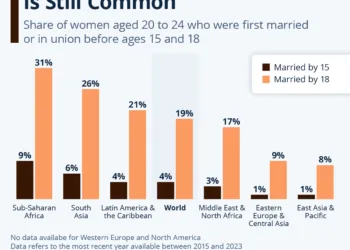The Gender Imbalance of Care Work
Understanding Care Work and Its Gender Dimensions
Care work encompasses a wide array of activities aimed at supporting the well-being of individuals—this includes childcare, elderly care, and support for people with disabilities. While care work is essential for the functioning of families and communities, it has predominantly fallen to women. This phenomenon is not merely an issue of individual choice but reflects systemic societal norms and expectations that shape gender roles.
The Statistics: A Snapshot of Gender Roles in Care Work
Recent data from the International Labour Organization (ILO) illustrates that care work remains highly gendered across various sectors. Notably, occupations such as nursing and midwifery, childcare, and roles within nursing homes or private households are overwhelmingly filled by women.
The staggering figure of approximately 708 million women globally being excluded from the labour force due to unpaid care responsibilities starkly emphasizes the burden women bear. This figure signifies not just a personal choice but an institutional failure to recognize and redistribute care work.
The Types of Care Work Primarily Undertaken by Women
Childcare
Childcare is one of the most visible forms of care work traditionally assigned to women. Mothers, grandmothers, and female relatives often take on these responsibilities without compensation, which leads to a significant gender gap in labor market participation. The expectation that women should manage children’s upbringing, education, and emotional well-being contributes significantly to the gender imbalance in employment.
Elderly Care
As populations age worldwide, the demand for elderly care has increased. Women disproportionately fill roles as caregivers in both professional and domestic environments, often balancing this with traditional job responsibilities. This form of care work is typically underpaid and undervalued, reflecting broader societal views about the worth of caregiving tasks.
Domestic Work
Work in private households, often performed by women, includes cleaning, cooking, and other maintenance tasks. Many domestic workers operate within informal arrangements, receiving little to no protections or benefits. The invisibility of this work complicates discussions around labor rights and gender equality.
The Societal Implications of Gendered Care Work
Economic Consequences
The economic ramifications of gendered care responsibilities extend far beyond individual households. Women’s exclusion from the formal labor market due to their caregiving roles diminishes overall economic productivity. This leads to a cycle in which economies are unable to fully harness the potential of their workforce, ultimately hampering growth and innovation.
Social Equity
The disproportionate responsibility of care work on women impacts not only their economic standing but also their social equity. The often-unrecognized sacrifices limit women’s access to education, career advancement, and overall personal development. Gendered divisions of labor thus perpetuate systemic inequalities, leaving many women in precarious situations.
The Need for Policy Reform
Recognition of Care Work
To address these issues, it’s imperative for policymakers to recognize the value of unpaid care work. Metrics for measuring productivity and economic contributions should include the impact of care work to provide a more holistic view of workforce participation.
Support for Caregivers
Implementing policies that support caregivers, such as paid family leave, subsidized childcare, and flexible work arrangements, can alleviate some of the burdens women face. These measures could enable more women to participate in the labor market, leveling the playing field and benefiting society overall.
Promoting Shared Responsibility
Encouraging shared responsibility in care work among all genders is essential. Educational campaigns that promote equitable parenting and caregiving responsibilities can shift societal norms and expectations, ultimately encouraging men to take a more active role in care work.
The Global Perspective on Gender Imbalance
A global lens reveals that the gender imbalance in care work is not uniform. Cultural, economic, and political contexts influence how care work is distributed among genders in different societies. International collaboration and learning can foster better practices and policies aimed at achieving gender equality in care roles.
Conclusion
While this blog does not include a conclusion, the ongoing discussion about the gender imbalance in care work underscores the critical need for awareness-raising and actionable changes within societies. Addressing the gendered nature of care roles can lead not only to greater equity but also to a more robust economy and healthier communities.






